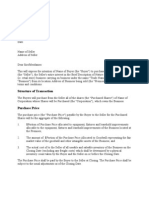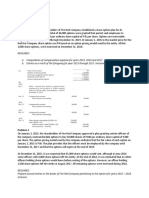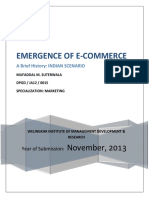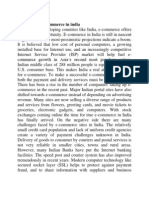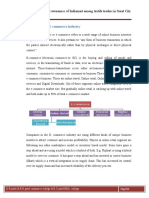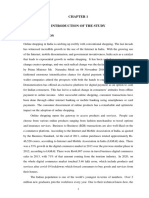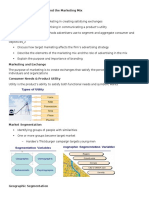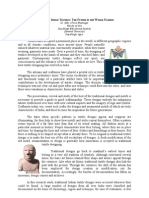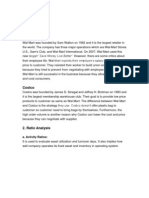Ecommerce A Crowed Bazar
Ecommerce A Crowed Bazar
Uploaded by
Nitin MungaparaCopyright:
Available Formats
Ecommerce A Crowed Bazar
Ecommerce A Crowed Bazar
Uploaded by
Nitin MungaparaOriginal Title
Copyright
Available Formats
Share this document
Did you find this document useful?
Is this content inappropriate?
Copyright:
Available Formats
Ecommerce A Crowed Bazar
Ecommerce A Crowed Bazar
Uploaded by
Nitin MungaparaCopyright:
Available Formats
EXPRESS
THE SUNDAY STORY 13
MARCH 4, 2012
Crowded
virtual bazaar
2011 saw online vendors hawking everything from books to apparels, cameras to LCDs. ARCHNA SHUKLA looks at why vendors are rushing to set up shop in a market with so few buyers
INDIA ONLINE IN NUMBERS
121 million Internet users in 97 million
2011 who accessed internet at least once in their life active users or those who access Internet at least once a month
18 million users in urban India who
access Internet daily active on social networking websites, including Facebook, Twitter, LinkedIn transanctions
30 million
10-30 million people do online
hold debit and credit cards
200 million (approx) people in India
e-commerce market
Rs 45,000 crore is the size of the
Rs 2,700 crore is the size of e-tailing
Source: Internet and Mobile Association of India, The Nielsen, Technopak and industry sources
HOW INDIA STACKS UP GLOBALLY, 2010
Size of e-commerce ($ billion) Internet users (mn) Online retail share of total retail in % Fixed broadband subscribers* Internet penetration *
US UK China India
250 53 486 98
81 85 36 8
27 31 9 1
173 61 80 0.6
4 7.7 1.1 0.3
lipkart, a nondescript ecommerce company launched in 2007 by two IIT-Delhi graduates, became a household name in India in 2011. The same year, hordes of vendors set up shop online, creating a buzz that couldnt be ignored. Indian buyers were suddenly inundated with deals they could not resist. There were books, music, films, mobile phones, digital cameras, pen drives, LCD screens, watches, apparels, perfumes, shoes, accessoriesall sold at attractive discounts. To avail of these, all that a customer needed was a screen with Internet access. E-commerce, after the crash and burn of 2000 and another failed attempt at resurrection in 2005, was back in 2011 and how! Discounts site snapdeal.com says that on a certain day last year, it sold 300 Gucci wallets, offered at 77 per cent discount, in 45 minutes and 100 telecom prepaid recharge coupons in one minute. On average, we have been selling 25,000 deals a day for the past several months, says Kunal Bahl, founder and CEO of the discount site. Binny Bansal, COO and co-founder of Flipkart, the booksmusic-films online retailer, claims to be shipping 30,000 items a day on average against 3,000 a little more than a year ago. Launched in mid2010, tradus.in, a shopping portal that also lists deals from other sites, says 70 per cent of its traffic comes from outside the top six metros in the country, which shows that online buying isnt merely a big city phenomenon.
Internet connections, Internet usage and online transactions are three different stages of evolution, says Laxman Narasimhan, Director, McKinsey and Company, India. And the country is at the entry level of the third stage. E-vendors claim close to 30 million Internet users have bought something online at least once. But some observers have a different take. There is too much hype in the Internet and e-commerce story, says Ajay Relan, a private equity veteran who has in the past led the venture capital arm of Citigroup in India and now runs his own private equity company CX Partners. Indeed, of the 121 million users estimated by IAMAI, only around 97 million access the Internet once a month. The number of those logging in everyday is even smaller at around 18 million. Arguing that the macro factors in India are still fluid, Bejul Somaia, the India Managing Director of Lightspeed Venture Parnters, a US-based venture capital firm, says, China has more than 250 million broadband connections, India has only around 10 million and the country is not likely to match up to China or the other big countries anytime soon. Somaia pegs the number of online buyers at around 10 million.
such as computing or the sale of smart phones. The flow of capital has helped vendors create new categories, strengthen logistics, build brands and improve the quality of their services. All these factors helped the market reach an inflection point in 2011, says Tagare.
Seeing Is Believing
It is no coincidence that e-commerce companies are today among the most prominent advertisers on television, the most expensive medium to advertise on, and in the print. Naaptol.com, a shopping and price-comparison site, was the second largest advertiser in the print in 2011, right behind Tata Motors and ahead of established names such as General Motors, Maruti Udyog, Samsung and Pantaloons Retail. The two things that turned around our business last year were the investments in our back-end operations and advertising, says Flipkarts Bansal. Snapdeals Bahl says, Once we were on TV, average buyers were convinced we were not some fly-by-night operators. Infused with cash, these companies are now investing in strengthening logistics, hiring talent and devising ways to make customers comfortable shopping online. Flipkart, for instance, introduced the cash-on-delivery model, a risky bet that paid off and now brings in 65 per cent of its revenues. Fetise.com, an online shopping portal for men, has introduced a cash-before-delivery model where its representatives collect the cash from buyers before delivering their orders. A lot of investment is also flowing into developing technologies that will help customers have the same buying experience that they get when they shop in a store. Several apparel sites, for instance, have features that help customers get a better view of the design and cut and some even have virtual trial rooms, where by using a webcam, customers can try out clothes. Technopak estimates that by 2020, the e-tail industry will grow to $70 billion and several local factors will push growth. Unlike most of its rival markets, organised retail in India is still an emerging industry and it is not likely to take off in a big way in the near future because of the high cost of real estate and borrowing funds, says Saloni Nangia, senior vice president, retail consulting division, Technopak. On the other hand, increased incomes and young consumers will push demand. This will propel the growth of non-store or virtual formats, she says.
The Real Bargain Hunters
Even at 30 million, the number of online buyers is too small to explain the phenomenon that e-commerce seems to have become in the past 12-18 months. Why are vendors of all kinds rushing to a market where the number of buyers is so small? A close look at the action on the ground shows that the real deal hunters in the India e-commerce story are not retail customers but investors. The number of Internet users has been growing steadily for the past few years but it is the investors who turned around the ecommerce story, says Pradeep Tagare, Investment Director, Intel Capital, India, the venture capital arm of the global chip-maker. Somaia of Lightspeed Venture says that the $1 billion valuation of travel portal makemytrip.com, a survivor of the 2005 crash, at the time of its listing on Nasdaq in 2010, tickled investors imagination. Because e-tailing in India is so small, it has the potential to grow 100 per cent to 200 per cent year-on-year. Its a very attractive proposition, especially in todays market where most other investment options are not too inspiring, he says. According to estimates, more than 50 e-tail ventures were launched between 2009 and 2011. These were backed by solid venture capital and private equity investors who parked more than $500 million in these startups in 2011 alone. Besides, strategic investors such as Intel Capital and Nokia Growth Partners are also pumping in funds in the sector in the hope that its growth will by default strengthen their own core business
India, An Internet Biggie?
The Internet and Mobile Association of India (IAMAI), the industry body that tracks online consumption, estimated that by the end of December 2011, there were at least 121 million Indians who had accessed the Internet at least once in their lifetime. This made India the fourth largest Internet market in the world after China, the US, and Japan. Retail consultancy Technopak estimates the e-commerce market in India is worth $10 billion, or around Rs 45,000 crore, and e-tailing makes for 6 per cent of this. (E-commerce includes all kinds of online dealings such as booking of flights and rail tickets, financial services such as banking and insurance, and other transactions along with e-tailing, which only includes retail goods transactions by end consumers). Though small, its a market thats growing fast. Technopak says it has grown 70 per cent in the last twothree years to $0.6 billion or around Rs 2,700 crore. But there are no official estimates on the number of online buyers. In the US and Japan, almost 90 per cent of the Internet population has online buying experience and its over 40 per cent in China. The corresponding number in India, however, is minuscule.
Source: Mckinsey & Technopak * % of population
CASUALTIES IN 2011
Taggle.com: After getting more than $9 million in investments from leading venture capital companies, the shopping site halted operations in December 2011 citing irrational price war. Vamoose.in: The site that offered discounts on leisure vacations has been offline for sometime. Nammagroceries.com: The online groceries site discontinued operations last year.
INVESTMENTS RAISED, 2011
$170 million
Flipkart.com
$40 million $25 million
Fashionandyou.com
$40 million
Snapdeal.com
The Danger Mark
Despite the ambition and the anticipation of the budding industry, the investors, its original believers, are beginning to have doubts. The game has just about begun and it is already too crowded, says Somaia. Relan points out that the industry is replete with me-too players with no
Naaptol Online
$300,000 $22 Mydala.com million
Homeshop18.com
differentiated business models and all of them riding on discounts. To be sure, there are already more than a dozen sites peddling coupons or discounted deals largely from local retailers. There are almost a dozen apparels sites selling similar products and brands even as new players continue to enter the scene. In a bid to cast their net wide, offline retailers such as Future Bazaar and the Aditya Birla Group have also entered the fray. There are also global e-commerce operators such as Fiftyone Inc that have begun free shipping to India products from global retailers such as Banana Republic. Certain categories like travel and consumer electronics are doing well online. Beyond these, other categories are still in the early stages of development and it will take them time to build traction, says McKinseys Narasimhan. Till that happens, online players will continue to burn cash to keep themselves going. Companies such as Flipkart, that have the first-mover advantage and are well-funded, have better chances of survival, say observers. Flipkart recently bought one of the largest consumer electronics vendor letsbuy.com, thus getting a head-start in a segment that offers better margins. It expected a 500 per cent jump in its 2011-12 revenues at Rs 450 crore before the acquisition. Insiders, however, point out that most companies quote the total value of orders delivered as the size of their revenues whereas their own margins are a tiny fraction of it. It is not surprising then that global biggie Amazon is still being cautious about India. After a long wait, the worlds largest online retailer made a fringe entry under the cover of a comparison shopping site junglee.com that it had acquired 13 years ago. The site merely directs customers to thirdparty retailers listed on its platform instead of selling anything directly. India is a difficult market. Besides a small base of buyers, it has several local challenges such as tying up with millions of merchandisers, catering to the diverse culture-orientations of consumers, and the small size of sales that make it a volume rather than a value game, says Krishna Motukuri, Managing Director, tradus.in. Motukuri worked with Amazon for seven years before moving to India and, without naming his former employer, says big fish might find swimming challenging here. Investors now realise that they will have to wait longer before their bets pay off. There are no cash flows in the business for the next four to five years and almost everyone is going to bleed, says Relan. He believes that this is not a business where too many players will survive. It is clear that it is a space where the winner will take it all and the others are going to fall flat. There is, however, no telling right now who the winner will be. As of now, everyone is in the race.
Coupons and deals sites
snapdeal.com mydala.com crazeal.com dealsandyou.com koovs.com khojguru.com coupondunia.com sosasta.com deals2buy.com coupondunia.com upto75.com mastsale.com
THE ME-TOO INDUSTRY
Apparels, shoes accessories, home products sites
myntra.com fashionandyou.com yebhi.com bestylish.com jabong.com brandsndeals.com fashionatclick.com theeverywomanshop.com ladybug.in yepme.com coollifeshop.com cbazaar.com shoppersbank.com
Sites for chidrens products
firstcry.com babyoye.com letbabyplay.com hoopos.com hushbabies.com babyvogue.com
Flowers and gifts sites
fernsnpetals.com floraindia.com indiagiftsportal.com allindiaflowers.com flowersfloristsgifts.com indiaflowerplaza.com
Shopping portals
homeshop18.com indiatimes.com shopping.rediff.com naaptol.com indiaplaza.com ebay.in retailmart.com retailsdirect.co bumperoffers.com
ILLUSTRATION: C R SASIKUMAR
You might also like
- Letter of Intent To Purchase Shares of A BusinessDocument3 pagesLetter of Intent To Purchase Shares of A BusinessLegal Forms88% (8)
- ASOS Business Strategy Report Final-2Document18 pagesASOS Business Strategy Report Final-2Emma Kenneth75% (8)
- Dissertation ReportDocument89 pagesDissertation Reportaryaaayush100% (4)
- Share-Based Payments With Answer PDFDocument9 pagesShare-Based Payments With Answer PDFAyaka FujiharaNo ratings yet
- Limestone Mining Reserves and ValuationDocument5 pagesLimestone Mining Reserves and ValuationrannscribdNo ratings yet
- The Digital Banking Revolution: How Financial Technology Companies Are Rapidly Transforming Retail BankingFrom EverandThe Digital Banking Revolution: How Financial Technology Companies Are Rapidly Transforming Retail BankingRating: 4 out of 5 stars4/5 (4)
- Summary of Marco Iansiti & Karim R. Lakhani's Competing in the Age of AIFrom EverandSummary of Marco Iansiti & Karim R. Lakhani's Competing in the Age of AINo ratings yet
- Black Book 2019Document74 pagesBlack Book 2019Nidhi Enterprises0% (1)
- Research Proposal E-RetailingDocument10 pagesResearch Proposal E-RetailinghunnygoyalNo ratings yet
- Amazon's Foray Into India - ReportDocument21 pagesAmazon's Foray Into India - ReportSomdeb BanerjeeNo ratings yet
- Ecommerce-Flipkart Fund RaisingDocument5 pagesEcommerce-Flipkart Fund RaisingAnkit BawaNo ratings yet
- B2C E-Commerce Thesis (Market Research Extract)Document4 pagesB2C E-Commerce Thesis (Market Research Extract)jgabriel_islas100% (1)
- E Commerce GenNextDocument8 pagesE Commerce GenNextmeattleNo ratings yet
- 44 AmazonDocument16 pages44 AmazonJay P. DesaiNo ratings yet
- 7 Sabyasachi Das 717 Research Communication MBA June 2012Document12 pages7 Sabyasachi Das 717 Research Communication MBA June 2012joshibuvaNo ratings yet
- Case StudyDocument5 pagesCase StudySoumya Ganguly100% (1)
- Intrusion Detection Tool Senior Citizen MediclaimDocument5 pagesIntrusion Detection Tool Senior Citizen MediclaimHimali ShetyeNo ratings yet
- Flipkart ReportDocument9 pagesFlipkart ReportNikhil Mahajan100% (1)
- E MarketingDocument71 pagesE MarketingMUFADDAL SUTERWALANo ratings yet
- E-Commerce in India: Market Size and GrowthDocument3 pagesE-Commerce in India: Market Size and GrowthPriyankNo ratings yet
- What Went Wrong With Snap Deal?Document77 pagesWhat Went Wrong With Snap Deal?Jeetendar PeswaniNo ratings yet
- Online Shopping TrendsDocument8 pagesOnline Shopping Trendsmerathod007No ratings yet
- Paper 1Document8 pagesPaper 1ronakideaNo ratings yet
- Project Report Bba 6TH SemDocument166 pagesProject Report Bba 6TH SemHarsh AgarwalNo ratings yet
- Ecommerce in IndiaDocument8 pagesEcommerce in IndiaSrinivas GotetyNo ratings yet
- Digital Marketing ReportDocument42 pagesDigital Marketing ReportMudit Chopra67% (3)
- Research Report ON The Growth of E-Commerce in India & Operation and Supply Chain Management of AmazonDocument40 pagesResearch Report ON The Growth of E-Commerce in India & Operation and Supply Chain Management of AmazonParth MehtaNo ratings yet
- E RetailDocument5 pagesE RetailDadi MadhuNo ratings yet
- International Journal of Business and Management Invention (IJBMI)Document4 pagesInternational Journal of Business and Management Invention (IJBMI)inventionjournalsNo ratings yet
- Neeraj Ecommerce in IndiaDocument56 pagesNeeraj Ecommerce in IndiaAadarshNo ratings yet
- A Management Research Project Proposal ON: Prospects of E-Retailing"Document10 pagesA Management Research Project Proposal ON: Prospects of E-Retailing"Kamran KhanNo ratings yet
- A Study On The Rise of E-Commerce From Indian Perspective - Flipkart and Its Liquidation MarketDocument11 pagesA Study On The Rise of E-Commerce From Indian Perspective - Flipkart and Its Liquidation MarketIJRASETPublicationsNo ratings yet
- Growth of Ecommerce in IndiaDocument5 pagesGrowth of Ecommerce in IndiaTittu Merin JosephNo ratings yet
- Growth of Online Commerce Leading To Emergence of New PlayersDocument7 pagesGrowth of Online Commerce Leading To Emergence of New PlayersKirti ShekhawatNo ratings yet
- Marketing Strategy of Tata CliqDocument12 pagesMarketing Strategy of Tata CliqUtsav100% (1)
- Market Research Online GroceryDocument32 pagesMarket Research Online Groceryswapnil chonkar50% (2)
- Retail PDFDocument24 pagesRetail PDFvamsiNo ratings yet
- PROJECT-REPORT-BBA-6TH-SEM-Copy-docxDocument73 pagesPROJECT-REPORT-BBA-6TH-SEM-Copy-docxprof.sarwansingh13No ratings yet
- A Study On Brand Awareness of Indiamart Among Textile Traders in Surat City Yash SarawagiDocument65 pagesA Study On Brand Awareness of Indiamart Among Textile Traders in Surat City Yash SarawagiYash SarawagiNo ratings yet
- Top 10 Items Sold OnlineDocument7 pagesTop 10 Items Sold OnlineAmartya_89No ratings yet
- E - Commerce in IndiaDocument10 pagesE - Commerce in IndiaPreet kaurNo ratings yet
- IJRAR19D5771Document6 pagesIJRAR19D5771thespyeyeseverywhereNo ratings yet
- Boom of eDocument12 pagesBoom of eaishaNo ratings yet
- A Guide To E-Commerce in India: APRIL 2020Document10 pagesA Guide To E-Commerce in India: APRIL 2020Venke JayakanthNo ratings yet
- Review of LiteratureDocument5 pagesReview of Literaturefor fun100% (1)
- Ecommerce-In India-project-SunilBrid-2022-2023-Sem IV-Sales and MarketingDocument57 pagesEcommerce-In India-project-SunilBrid-2022-2023-Sem IV-Sales and MarketingJagdishNo ratings yet
- <!DOCTYPE HTML PUBLIC "-//W3C//DTD HTML 4.01 Transitional//EN" "http://www.w3.org/TR/html4/loose.dtd"> <HTML><HEAD><META HTTP-EQUIV="Content-Type" CONTENT="text/html; charset=iso-8859-1"> <TITLE>ERROR: The requested URL could not be retrieved</TITLE> <STYLE type="text/css"><!--BODY{background-color:#ffffff;font-family:verdana,sans-serif}PRE{font-family:sans-serif}--></STYLE> </HEAD><BODY> <H1>ERROR</H1> <H2>The requested URL could not be retrieved</H2> <HR noshade size="1px"> <P> While trying to process the request: <PRE> TEXT http://www.scribd.com/titlecleaner?title=neeraj.docx HTTP/1.1 Host: www.scribd.com Proxy-Connection: keep-alive Accept: */* Origin: http://www.scribd.com X-CSRF-Token: 5505492a155d342cb671e0cd31fe18b0753bff97 User-Agent: Mozilla/5.0 (Windows NT 6.1) AppleWebKit/537.36 (KHTML, like Gecko) Chrome/29.0.1547.57 Safari/537.36 X-Requested-With: XMLHttpRequest Referer: http://www.scribd.com/upload-document?archive_doc=43274298&metadata=%7B%22actioDocument16 pages<!DOCTYPE HTML PUBLIC "-//W3C//DTD HTML 4.01 Transitional//EN" "http://www.w3.org/TR/html4/loose.dtd"> <HTML><HEAD><META HTTP-EQUIV="Content-Type" CONTENT="text/html; charset=iso-8859-1"> <TITLE>ERROR: The requested URL could not be retrieved</TITLE> <STYLE type="text/css"><!--BODY{background-color:#ffffff;font-family:verdana,sans-serif}PRE{font-family:sans-serif}--></STYLE> </HEAD><BODY> <H1>ERROR</H1> <H2>The requested URL could not be retrieved</H2> <HR noshade size="1px"> <P> While trying to process the request: <PRE> TEXT http://www.scribd.com/titlecleaner?title=neeraj.docx HTTP/1.1 Host: www.scribd.com Proxy-Connection: keep-alive Accept: */* Origin: http://www.scribd.com X-CSRF-Token: 5505492a155d342cb671e0cd31fe18b0753bff97 User-Agent: Mozilla/5.0 (Windows NT 6.1) AppleWebKit/537.36 (KHTML, like Gecko) Chrome/29.0.1547.57 Safari/537.36 X-Requested-With: XMLHttpRequest Referer: http://www.scribd.com/upload-document?archive_doc=43274298&metadata=%7B%22actioAtul ChandraNo ratings yet
- Growth of E Commerce in IndiaDocument10 pagesGrowth of E Commerce in Indiavinayvasant20200% (1)
- Online Retailing in IndiaDocument5 pagesOnline Retailing in Indiadivisha_goyal11No ratings yet
- Digital ShowroomingDocument15 pagesDigital ShowroomingPavithra KNo ratings yet
- plagiarismDocument17 pagesplagiarismGowtham DineshNo ratings yet
- Ecommerce in India: Chillibreeze WriterDocument5 pagesEcommerce in India: Chillibreeze WriterDeepali R AparajNo ratings yet
- E Commerce PresentationDocument22 pagesE Commerce PresentationRachel Evans100% (1)
- Avi EcommerceDocument11 pagesAvi EcommerceAvinash JangraNo ratings yet
- IJCRT2204559Document18 pagesIJCRT2204559Mohd AdnanNo ratings yet
- Consumer Perception Toward Online ShoppingDocument11 pagesConsumer Perception Toward Online ShoppingJIGNESH125No ratings yet
- Chapter 1Document18 pagesChapter 1jeevaa9597No ratings yet
- E-Commerce in India - WikipediaDocument14 pagesE-Commerce in India - Wikipediapyashodamma97No ratings yet
- History of E-CommerceDocument3 pagesHistory of E-CommerceFiza KapoorNo ratings yet
- AI in Online Business: Automation, Personalization, and Success in the NetworkFrom EverandAI in Online Business: Automation, Personalization, and Success in the NetworkNo ratings yet
- The Small Business Guide to Apps: How your business can use apps to increase market share and retain more customersFrom EverandThe Small Business Guide to Apps: How your business can use apps to increase market share and retain more customersNo ratings yet
- Questions 1 Through 4Document8 pagesQuestions 1 Through 4ssregens82No ratings yet
- Hadi Ka DachaDocument55 pagesHadi Ka DachaVijay TendolkarNo ratings yet
- Mark Casson - An Entrepreneurial Theory of FirmDocument42 pagesMark Casson - An Entrepreneurial Theory of Firmhistoriadors100% (1)
- Midlands State University: Module: Marketing of Financial Services (Mmrk812)Document58 pagesMidlands State University: Module: Marketing of Financial Services (Mmrk812)Maxwell DziyaNo ratings yet
- Segmentation, Targeting, and The Marketing MixDocument12 pagesSegmentation, Targeting, and The Marketing MixMatthew YuNo ratings yet
- Chapter 6 - Web, Store-Based, and Other Forms of Nontraditional RetailingDocument34 pagesChapter 6 - Web, Store-Based, and Other Forms of Nontraditional RetailingNICHOLAS NARTEY KWAPONGNo ratings yet
- Generic StrategyDocument7 pagesGeneric StrategyAmit GuptaNo ratings yet
- Moniter PerformanceDocument3 pagesMoniter PerformanceAakash SharmaNo ratings yet
- Bond & Stock ValuationDocument37 pagesBond & Stock ValuationSara KarenNo ratings yet
- Cheat SheetDocument2 pagesCheat SheetDimana Dollo100% (1)
- 5 Key Steps To Successful Active TradingDocument25 pages5 Key Steps To Successful Active TradingFábio NunesNo ratings yet
- Komal 1234Document78 pagesKomal 1234PRIYANo ratings yet
- Traditional Indian TextilesDocument3 pagesTraditional Indian TextilesParul Bhatnagar100% (3)
- Service Sector Marketing Mix 8 P'sDocument40 pagesService Sector Marketing Mix 8 P'sPraveen MayarNo ratings yet
- Nivea FinalDocument3 pagesNivea FinalMaiAsis100% (1)
- TL10Document13 pagesTL10ngothimyhoadueNo ratings yet
- 4 Financial Management ND2020Document4 pages4 Financial Management ND2020Srikrishna DharNo ratings yet
- Top 5 Important Factors Influencing Consumer BehaviourDocument7 pagesTop 5 Important Factors Influencing Consumer BehaviourAnoop Ajayan100% (1)
- Marketing Analysis Practical 4Document12 pagesMarketing Analysis Practical 4Mrunal WaghchaureNo ratings yet
- Entrepreneur Walmart and CostcoDocument9 pagesEntrepreneur Walmart and Costcop0860270No ratings yet
- Online Electricity Bill Payment: Thank You!Document1 pageOnline Electricity Bill Payment: Thank You!nanidoppiNo ratings yet
- 59456181584Document3 pages59456181584Abeer Abd ElatifNo ratings yet
- Hicks Theory of WagesDocument22 pagesHicks Theory of Wagestai2000No ratings yet
- IA EconomicsDocument3 pagesIA EconomicsElisa ElisaNo ratings yet
- Comparative Analysis of Retail Value Proposition of Caprese and BaggitDocument18 pagesComparative Analysis of Retail Value Proposition of Caprese and Baggitshona75No ratings yet
- E3 MM: Cooperative Marketing: Business AdministrationDocument3 pagesE3 MM: Cooperative Marketing: Business AdministrationStephanie JaneNo ratings yet
